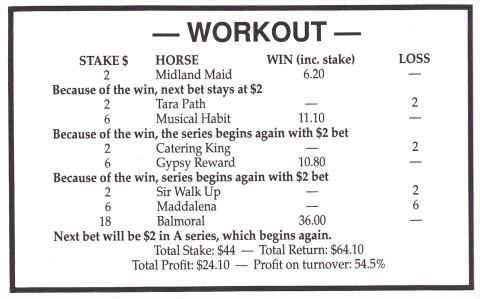Let me say immediately that to win with the method I am about to outline, you must employ commonsense. Lots of it. Do this and you will make plenty of money, albeit that you are betting only for a place.
The one paramount rule you must obey is this: Never back a horse you think MIGHT run a place! This is the incorrect approach and one that will, inevitably, lead to your financial demise. The approach to use is the positive one of only backing a horse for a place that you are confident can WIN the race.
In other words, although you are backing for a place, you are actually looking for winners. Don't go after the 'might' horses at longer odds because you'll find that over a period of time you will begin to fall behind. Now, the plan which I call The Crackerjack – based on progression betting, so if that sort of method is not to your liking, you should stop reading now! I do advise you, though, to spare a few minutes to examine what I have to say; I'm sure you'll benefit.
A test on this method some time ago, backing the outright favourite in each race, produced a profit of more than $74 in Sydney and $37 in Melbourne-a more than excellent return considering you would have been backing race-to-race. It's my view that a punter who could come up with the right selections could quite easily make 25 per cent profit on turnover in a 12-month period. That's a fantastic return for place betting.
The rules are simple enough; just take your time and absorb what I have to say.
You use THREE betting divisions. You can bet in units to suit your capital, a unit being worth 50 cents, $1 or $10 or $100, whatever you like. You will need a $200 bank if you bet in $2 units (as our example does). The betting divisions are as follows:
| A | B | C |
|---|
| $2.00 | $4.00 | $8.00 |
| $6.00 | $12.00 | $24.00 |
| $18.00 | $36.00 | $72.00 |
You begin, naturally, by playing the A division. If at any time you back a placegetter which gives you a return of $3 for your $2 bet (in other words, 1-2 on) the A series is completed and you start again. If you happen to back a placegetter at shorter than 1-2 you repeat the bet next time. If you simply back a loser with your $2 bet you move on to $6. A loser with that bet would take you to $18.
Should you strike three losers in a row (non-placegetters), or the $18 bet misses, you move on to the B division.
The progression and recession is the same, except that you do not drop back to the A division until you have a collect with your $36 bet. When in the B division, your $4 bet is repeated if the odds received are less than 1-2. If the $4 bet loses, you go to $12. Should you hit a dividend of 1-2 or better you go back to $4. If a $12 bet loses you move to $36. A win here at 1-2 or better sends you back to the start of the A division.
Should the $36 bet in the B division fail then you move on to the C bracket and continue the same rules. A win with a $72 bet would see you begin again with the A division.
There is a safety-net rule with this method. When the third horse in either divisions A or B fills a place at less than 1-2 then do NOT repeat until you add up the investment and return columns. If the series is showing a profit to that point it would be safer to accept it and return to the original stake. This rule stops you from getting into the higher betting divisions too quickly.
You can handle this as you see fit. Some of you will be confident enough not to need the safety-net cover. But do be realistic about things.
To give you a clear idea of how The Crackerjack works, I have listed my bets from the meetings held on August 8. This particular day I was betting in $20 amounts and made a profit on the day of $290. I have, however, listed the workout in $2 units. I was betting on-course and obtained a few better dividends for place bookies than the TAB paid, but the workout contains TAB divvies.
I am sure this Crackerjack method will eminently suit those punters who fancy themselves as good tipsters and who want to operate a place-staking method that enables them to achieve good wins, without a great deal of wild risk-taking. I do emphasise again, though, that your selections have to be sound ones.
Don't forget the old maxim: PICK 'EM TO WIN AND PLAY'EM TO PLACE.

By Jon Hudson
PRACTICAL PUNTING - OCTOBER 1987